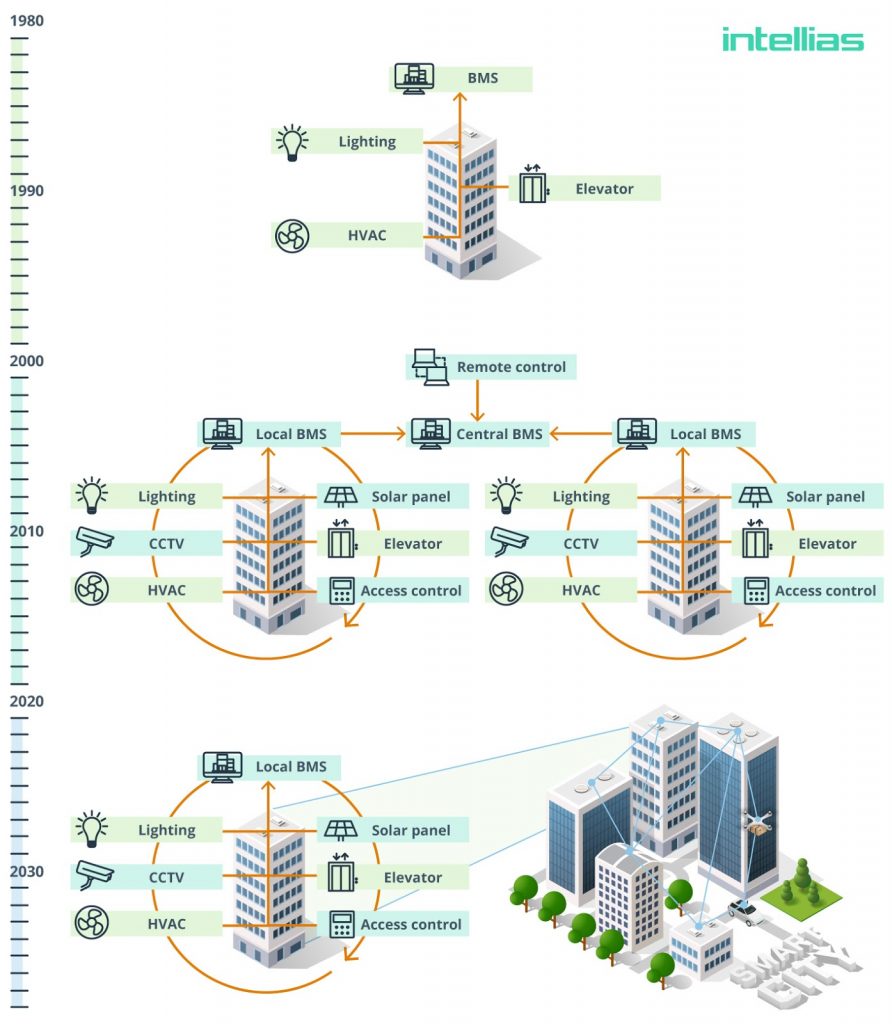The complexity of new state-of-the-art buildings is skyrocketing; Aquariums, wedding chapels, rollercoasters, and even artificial canals are becoming the norm for office centres and shopping malls.
This is way too much to be efficiently managed by people alone, says Sergiy Seletskyi, IoT practice leader and senior solution architect at Intellias. And far too often, businesses have no idea how many resources their buildings waste and, more importantly, what it actually costs them.
Fortunately, technologies are getting more advanced, allowing for monitoring, automating, and optimising building operations. On the surface, it may seem that only digital-native businesses can leverage technological advancements. But that couldn’t be further from the truth.
Every single activity within a building can now generate data. Powered by IoT devices, a building management system (BMS) can collect and analyse data to offer granular visibility into what’s happening inside a building.
What is a BMS?
A building management system controls technical and electrical installations in a building by maintaining predefined parameters according to changing conditions.
Fifty years ago, the functionality of early BMSs was limited to simply switching on or off the right equipment at the right time of the day or year. But even these basic commands eased the management of essential facility assets such as lighting, pumps, elevators, and HVAC systems.

Over the years, a staggering range of new systems have appeared for everything from fire and smoke detection to video surveillance and security, switchable glass, exterior shading, water reclamation, and renewable energy.
Every new subsystem further burdens and increases the complexity of the entire facility management infrastructure. To address the challenge of maintaining and optimising building operations, BMSs evolved into complex IT infrastructure with layers of communication protocols, networks, and controls that integrate all subsystems into one ecosystem.
Today, an IoT-powered BMS offers significant opportunities for reducing energy consumption through HVAC monitoring, heat map analysis, and predictive maintenance. With a modern BMS, facility managers get a holistic view of a building’s operations, helping them make informed, business-critical decisions.
In the future, BMSs will get even more intelligent, enabling communication between buildings and bringing us toward a collaborative smart city ecosystem.
How does a BMS work?
A BMS architecture usually comprises four basic groups of devices; sensors, controllers, output devices, and a user interface.
At first, you configure the system via a control panel with a user interface. For example, you might set a daily schedule for temperature changes. Sensors collect whatever data you need about the building, whether it’s environmental conditions or energy consumption of systems and equipment.
Based on your settings and the information gathered by sensors, controllers decide on system adjustments for instance, to regulate the amount of outside air intake according to the CO2 level in the room. Then, output devices relays and actuators execute commands received from the controllers. At any time, you can use the control panel to monitor reported data, assess the BMS performance, and change settings if desired.
What are the benefits of a BMS?
Energy savings
Among the numerous benefits of implementing a BMS, energy savings is the most significant. Since cutting down on energy consumption directly means reduced energy spending, saving power improves a business’s profitability. Some estimates suggest that a BMS with strong data analytics can help reduce energy consumption by 30%.
Let’s look at a common use case; A BMS combines data on HVAC operations and the weather forecast to help you develop a strategy for optimising operating costs on a hot day. Knowing in advance the periods of high demand when energy is more expensive, you can cool the building earlier in the day to avoid high charges. Another example is integrating a schedule of meetings or events to automatically adjust lighting, air conditioning, or heating where they will occur.
Predictive maintenance
A BMS with IoT sensors embedded in equipment can provide real-time data about power use, temperature, vibration, and other measurements. An AI-powered analytics platform can learn patterns in hardware operations to identify deviant performance and alert about imminent malfunctions. Thus, it can help you save on emergency repairs.
Predictive maintenance is particularly useful at industrial plants to avoid breakdowns of costly equipment, since even a small operational interruption may cause enormous financial losses. Restaurants and grocery stores can also use IoT sensors to monitor refrigeration units to ensure their produce is always fresh.
Enhanced security
A BMS can significantly strengthen a building’s security and save tangible assets, intellectual property, and above all, human life. Based on data from gas and smoke detectors, a BMS system can instantly open up emergency routes and give occupants directions to exits, saving precious time during an evacuation.
Closed-circuit television, motion sensors, and glass break detectors provide superior real-time intrusion control. For example, say a camera sees two people entering the building together at off-hours. The system checks the entrance log to find out how many people carded in at the specified door at the specified time. If two people carded in, the system returns to monitoring; otherwise, it alerts security about possible unauthorised access.
Personalised environment
To create a dynamic and comfortable environment for occupants, a BMS collects information from connected sensors, beacons, Wi-Fi network, and PC activity. Using this information, you can provide your employees, customers, or guests with a unique presence experience.
Consider a simple use case; Access control cards are programmed with cardholders’ credentials, including personalised climate preferences. Integrated into the BMS, these settings are then applied based on a person’s location within a building.
How does this technology suit your business?
By adopting an IoT-based BMS for new and retrofitted facilities, you can optimise operations within your properties, save on energy consumption, ensure strong security, and review the way you use space and assets.
You might say that a BMS works with new buildings that were designed to be smart. But how about older buildings? Older buildings can be retrofitted and automated in smaller but still smart ways, becoming important pieces of the sustainability puzzle.
Technological transformation is not for digital businesses only. It’s for everyone willing to embrace and benefit from advanced technology.
The author is Sergiy Seletskyi, IoT practice leader and senior solution architect at Intellias.
About the author
Sergiy helps companies harness the right IoT technology stack to scale business and make it future-proof. Strategic thinker with extensive knowledge of the IT Industry in a wide variety of innovative solutions for different business domains.
Comment on this article below or via Twitter: @IoTNow_OR @jcIoTnow










